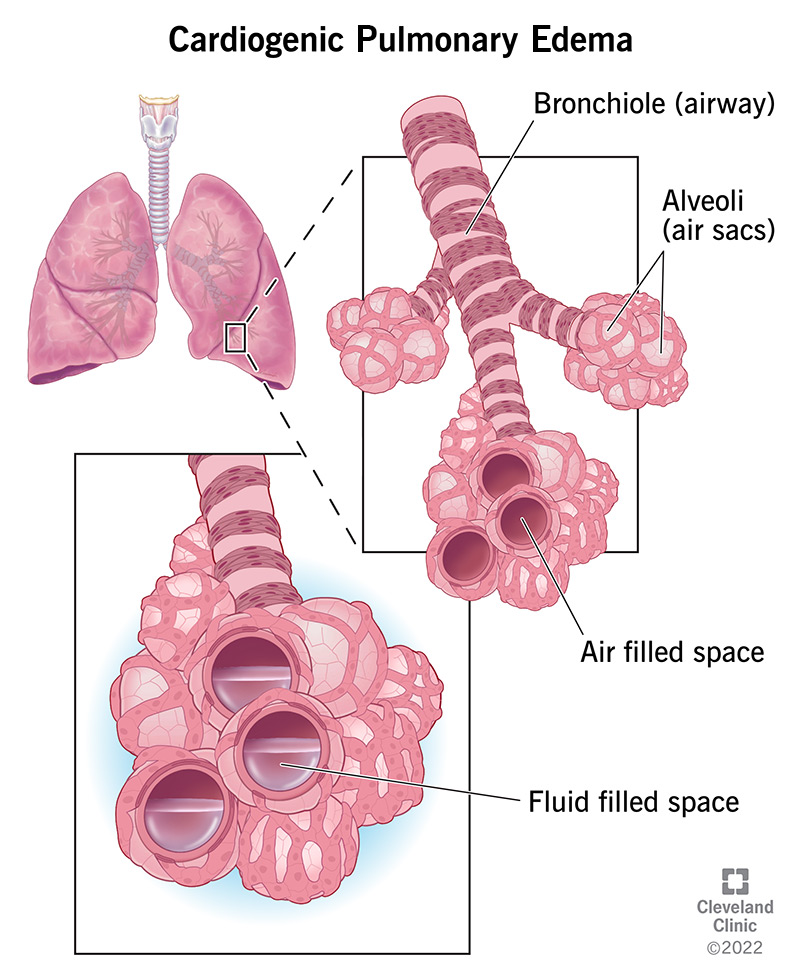Cardiogenic pulmonary edema is a life-threatening accumulation of excess fluid in your lungs because of pressure in your heart. Medications can get rid of the extra fluid, but your healthcare provider may need to do procedures as well. Treatments vary depending on the cause. The outlook for this problem depends on what’s causing your edema.
Advertisement
Cleveland Clinic is a non-profit academic medical center. Advertising on our site helps support our mission. We do not endorse non-Cleveland Clinic products or services. Policy

Cardiogenic pulmonary edema is an accumulation of extra fluid in your lungs that can be life-threatening. This comes from pressure going up and blood collecting on the left side of your heart, usually because of heart failure. In addition to difficulty breathing, cardiac edema can lead to organ damage from a lack of enough oxygen.
Advertisement
Cleveland Clinic is a non-profit academic medical center. Advertising on our site helps support our mission. We do not endorse non-Cleveland Clinic products or services. Policy
Both of these mean you have too much fluid in your lungs, which makes it hard for you to breathe. Cardiogenic pulmonary edema is a type of pulmonary edema with a heart problem as its cause. An injury to your lungs causes the non-cardiogenic type of pulmonary edema.
These are both names for excess fluid in your organs. With cardiac edema, there’s too much fluid in your lungs. With renal edema, there’s too much fluid in your kidneys. Heart failure can cause both of these. Also, your kidneys can’t get enough fluid out of your blood and into your pee.
Cardiac edema affects people with heart conditions, especially heart failure. About 6 million American adults have heart failure. An estimated 80% of people with heart failure have pulmonary edema.
Symptoms of cardiogenic pulmonary edema include:
Congestive heart failure is the most common cause of heart edema. Other causes include:
Advertisement
Your healthcare provider will:
After your exam, your provider may order these tests that help show what’s going on:
Procedures or invasive treatments for cardiac edema include:
Your healthcare provider may prescribe:
If you have heart failure, your healthcare provider will ask you to take salt out of your diet. This includes salt you add to food and salt that’s already in prepared or processed foods.
Other things that may help:
Pulmonary edema is life-threatening, but your prognosis depends on what caused it. One year after discharge from a hospital, about 50% survive cardiac edema.
Heart failure, a common cause of cardiogenic pulmonary edema, is a chronic disease that can get better with treatment. Out of every three people who’ve been in the hospital because of heart failure, one person lives five or more years after their stay.
Since cardiogenic pulmonary edema happens when you already have a problem with your heart, the best way to reduce your risk is by keeping your heart strong and healthy.
Ways to do that include:
Weighing yourself every day at the same time can help you know if your cardiac edema is getting worse. It may be easiest to step on your scale before breakfast, but after you pee. If you gain more than two pounds a day, your body is probably retaining fluid.
You should contact your provider if you have:
Call 911 if you’re having trouble breathing or if you’re having chest pain.
Advertisement
When your healthcare provider diagnoses and treats your cardiogenic pulmonary edema early, it’s better than if you wait to get care. This is why it’s good to keep going to your regular checkups with your provider. They can keep an eye on any cardiac issues you have that may lead to cardiac edema. Taking the medicines they give you can prevent heart problems you have from getting worse.
Advertisement
Cleveland Clinic can diagnose and treat heart failure of any kind, at any stage, with advanced therapies and compassionate care.

Last reviewed on 04/30/2022.
Learn more about the Health Library and our editorial process.